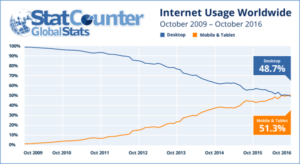
What you need to know:
It’s official – mobile search now drives more search queries than desktop search.
- 58% of overall search query volume in the U.S. comes from mobile searches (Hitwise)
- Over 50% of Google’s global search queries come smart mobile devices (Google)
- Google has about 95% of the global market share when it comes to mobile searches (Statcounter)
Here are the details, and recommendations about what you can do in response to this important shift in online behavior.
Google Confirms Mobile Search Passes Tipping Point
For the very first time mobile search has overtaken desktop queries worldwide. In the U.S., as well mobile is quickly catching up with desktop and is likely to surpass it in near future.
Not too long ago, Google itself has come forward to state that more than 50% of its global search queries are now coming directly from smart mobile devices. This has forced Google to consider mobile optimization of websites when configuring SERPs.

Source: StatCounter
Google has about 95% of the global market share when it comes to mobile searches, according to extensive data from StatCounter. Google says: “Google Search will be expanding its use of mobile-friendliness as a ranking signal. This change will affect mobile searches in all languages worldwide and will have a significant impact in Google Search results.”
This is a clear indication that search engines are recognizing the importance of mobile search. The growing impact of mobile search is being backed up by various different market analyses.
Desktop Queries are Facing a Decline
The most recent PC search market share and query volume figures made available by comScore reveal that almost all of the search engines have seen downward trends when it comes to volume of desktop-queries.
Google’s desktop queries went from 15, 303 millions in November to 14, 954 in December of 2016. This trend is expected to continue in months and years to come.
Consumers on the Go Prefer Mobile
Hitwise, a division of Connexity that examines overall trends in mobile search in the United States has recently issued John Fetto’s consumer insight report titled “Mobile Search: Topics and Themes”. This report has extensively inspected hundreds of millions of online queries on all major search engines, relating to 11 different industries.
The results indicate that the era of desktop dominance has ended.
Desktop searches still account for a significant number of online queries in some areas; however, mobile searches are quickly taking over in many others. According to the report, “location-based searches, like those specifying ‘near me’ are consistently among those most heavily—nearly exclusively—initiated on mobile devices.”
This makes sense as smartphones and other mobile devices allow the consumers to access their desired websites and Apps on the go. GPS and other smart Apps help find out the exact location of consumers’ favorite services.
When it comes to location based searches most consumers find mobile devices more convenient.
Mobile Search is the Future
Hitwise’s detailed analysis of several leading industries indicates that about 58% of overall search query volume in the U.S. comes from mobile searches.
Health, sports, news, lifestyle, entertainment, etc are all the industries that are being searched more extensively on the smartphones. The number of sectors where mobile is gaining grounds is on the rise and this upward trend is not likely to be temporary.
Businesses need to be aware of the platform their consumers are using to access their products and services. Marketers and SEO teams should work to harness the power of mobile search to access more consumers and increase the conversion rates by using mobile-dominant themes on their representative websites.
What You Can Do
Yes it’s hard to believe but even in 2017 a lot of websites are not mobile friendly but a lot of organizations just haven’t been able to prioritize the shift to mobile. Here’s just one example:
Here are three things you should prioritize right away if you want to be ready for the ongoing increase in mobile traffic.
- Don’t make a separate mobile-friendly website – Not only does this create more work for you, Google can actually see this as duplicate content and penalize your Search Engine rankings as a result of this approach.
- Use responsive design – This approach uses media queries (specialized style sheets) to to recognize what device your visitor is using and present the page in the format that is best for their experience.
- Be easy to read, easy to click – Let’s face it, these are the two things we do on mobile web-site the most. Shouldn’t it be easy. Font size should usually be at least 14px in size to keep people from having to pinch-and-zoom to read. Also – it might be time to reconsider all that information you have in PDF’s. Have you ever tried to read a PDF on a smartphone? Yea – your visitor’s don’t like it either. Find natural ways to take that information out of PDFs and put them into web pages.
Options for Moving to a Mobile Responsive Site
-
Redesign
If your site is out-dated enough to not be mobile responsive, the simplest approach might be a web-site redesign. Often we find that non-mobile websites live in out-dated environments that are difficult to update, and frankly the information on them is usually out of date anyway. Shifting to a mobile responsive site can often be just the push a company needs to get the content of their site up to date.
-
Convert Your Existing Site
Do you need to move to a mobile responsive site, but you’re not ready for an outright redesign? Updating to a Mobile Responsive is still possible – and easier than you might think. Depending on the CMS (Content Management System) you use – becoming mobile friendly could simply be solved by a new theme or set of media queries.
Whatever you do, it’s important that you test your website for mobile responsiveness and address it as soon as you can.
Need help creating a Mobile Responsive website? We’d be happy to help. Feel free to contact us.








